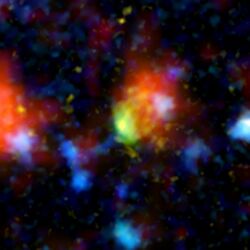Astronomy:Baby Boom Galaxy
| Baby Boom Galaxy | |
|---|---|
 Baby Boom Galaxy (Green-Red Splotch) | |
| Observation data (J2000 epoch) | |
| Constellation | Sextans |
| Right ascension | 10h 00m 54.52s[1] |
| Declination | +02° 34′ 35.2″[2] |
| Redshift | 280919 km/s[2] |
| Distance | 12.477 billion Light Years |
| Characteristics | |
| Type | Starburst galaxy,[1] SMG[3] |
| Other designations | |
| COSMOS 2328516,[2] Baby Boom Galaxy | |
The Baby Boom Galaxy is a starburst galaxy located about 12.477 billion light years away (co-moving distance is 25.08 billion light years).[1][4] Discovered by NASA's Spitzer Science Center at the California Institute of Technology, the galaxy is the record holder for the brightest starburst galaxy in the very distant universe, with brightness being a measure of its extreme star-formation rate.[5] The Baby Boom Galaxy has been nicknamed "the extreme stellar machine" because it is seen producing stars at a rate of up to 4,000 per year (almost 11 stars per day). The Milky Way galaxy in which Earth resides turns out an average of just 10 stars per year.[4]
Discovery
The Baby Boom Galaxy was discovered and characterized in 2008 using a suite of telescopes operating at different wavelengths. NASA's Hubble Space Telescope and Japan's Subaru Telescope, atop Mauna Kea in Hawaii, first spotted the galaxy in visible-light images, where it appeared as an inconspicuous smudge due to its great distance.[6] It wasn't until the Spitzer and the James Clerk Maxwell Telescope, also on Mauna Kea in Hawaii, observed the galaxy at infrared and submillimeter wavelengths, respectively, that the galaxy was formally discovered.[4]
Strange behavior
The Baby Boom Galaxy is named "The Baby Boom Galaxy", because it generates over 4,000 stars per year (compared to an average of just 10 per year for the Milky Way).[1][4][5] At that rate, the galaxy needs only 50 million years to create as many stars as the most massive galaxy ever observed.[7] The discovery also challenges the accepted model for galaxy formation, which has most galaxies slowly bulking up by absorbing pieces of other galaxies, rather than growing internally.[8] Another unusual aspect is the fact that scientists are observing this galaxy at a time when the universe was only a little over 1.4 billion years old, meaning that this galaxy was exhibiting this strange behaviour while the universe was still in its infancy.[5]
"This galaxy is undergoing a major baby boom, producing most of its stars all at once," said Peter Capak of NASA's Spitzer Science Center at the California Institute of Technology. "If our human population was produced in a similar boom, then almost all of the people alive today would be the same age."[4]
To that, the principal investigator of the Cosmic Evolution Surveyor, Nick Scoville of Caltech responded: "We may be witnessing, for the first time, the formation of one of the most massive elliptical galaxies in the universe."[7]
Colors
The red color on the galaxy represents the birth of new stars. The color green represents a denoted gas, while the blue shows other galaxies that are less active in producing stars.[9][10] See also Sextans Constellation.
See also
- Astronomy:Messier 82 – Starburst galaxy in the constellation Ursa Major
- Astronomy:Starburst galaxy – Galaxy undergoing an exceptionally high rate of star formation
References
- ↑ 1.0 1.1 1.2 1.3 "Super Starburst Galaxy - NASA". Caltech.edu. http://www.spitzer.caltech.edu/Media/releases/ssc2008-12/ssc2008-12a.shtml. Retrieved 2008-09-08.
- ↑ 2.0 2.1 2.2 "COSMOS 2328516". SIMBAD. Centre de données astronomiques de Strasbourg. http://simbad.u-strasbg.fr/simbad/sim-basic?Ident=COSMOS+2328516.
- ↑ arXiv, Spectroscopic Confirmation Of An Extreme Starburst At Redshift 4.547, Tue, 3 Jun 2008 22:59:35 GMT; doi:10.1086/590555 Bibcode: 2008ApJ...681L..53C
- ↑ 4.0 4.1 4.2 4.3 4.4 Press Release, NASA (July 10, 2008). "Rare 'Star-Making Machine' Found In Distant Universe". caltech.edu. Archived from the original on 2008-07-28. https://web.archive.org/web/20080728004641/http://www.spitzer.caltech.edu/Media/releases/ssc2008-12/release.shtml. Retrieved 2008-09-08.
- ↑ 5.0 5.1 5.2 Plait, Phil (July 10, 2008). ""Baby Boom" galaxy cranks out cranky booming babies". Discover Magazine. Archived from the original on 1 August 2008. https://web.archive.org/web/20080801090922/http://blogs.discovermagazine.com/badastronomy/2008/07/10/baby-boom-galaxy-cranks-out-cranky-booming-babies/. Retrieved 2008-09-08.
- ↑ "'Baby Boom' galaxy found in distant cosmos". Spaceinfo.com.au. Archived from the original on 2008-07-24. https://web.archive.org/web/20080724044509/http://www.spaceinfo.com.au/spitzer20080712.html. Retrieved 2008-09-08.
- ↑ 7.0 7.1 Space.com Staff (10 July 2008). "Cosmic Baby Boom Baffles Astronomers". Space.com. Archived from the original on 7 September 2008. https://web.archive.org/web/20080907184042/http://www.space.com/scienceastronomy/080710-star-birth.html. Retrieved 2008-09-08.
- ↑ Mirsky, Steve (July 17, 2008). "Baby Boom Galaxy Churning Out Stars". Scientific American. Archived from the original on 16 September 2008. https://web.archive.org/web/20080916075324/http://www.sciam.com/podcast/episode.cfm?id=31218966-0670-652E-8A231E3794D81660. Retrieved 2008-09-08.
- ↑ Nancy Atkinson (10 July 2008). "Baby Boomer Galaxy Found". http://www.universetoday.com/15492/baby-boomer-galaxy-found.
- ↑ Redd, Nola Taylor (April 17, 2013). "Baby Boom: Ancient Galaxy Fires Out New Stars at Record Pace". http://www.space.com/20709-ancient-starburst-galaxy-big-bang.html.
Coordinates: ![]() 10h 00m 54.52s, +02° 34′ 35.17″
10h 00m 54.52s, +02° 34′ 35.17″
[Baby Boomer Galaxy Found - Universe Today. (2008, July 10).|http://www.universetoday.com/15492/baby-boomer-galaxy-found/] Ancient Galaxy Fires Out New Stars at Record Pace. (n.d.). Retrieved Baby Boom: Ancient Galaxy Fires Out New Stars at Record Pace. (n.d.).
 |

